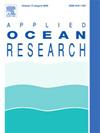Turbulence model adaptability at critical Reynolds numbers and applications in wake control via fairings
IF 4.4
2区 工程技术
Q1 ENGINEERING, OCEAN
引用次数: 0
Abstract
The water-drop shaped fairings with varying shape angles are attached to a circular cylinder to achieve wake control and vortex suppression at critical Reynolds numbers. To ensure the capability of Reynolds averaged Navier–Stokes (RANS), detached eddy simulation (DES) and large eddy simulation (LES) models at the critical Reynolds number region, three representative turbulence models are employed: LES with subgrid-scale (SGS) model, delayed DES model with improved wall-modeling capability (IDDES) and shear stress transport (SST) RANS model. These models are utilized to simulate flow around a circular cylinder at Reynolds number . The solver used in this paper is further developed based on the high-resolution algorithm platform for incompressible flow (HRAPIF). The comparative analysis of the results from the three turbulence models has been rigorously validated and investigated. An exhaustive examination of the mean flow field, Reynolds stresses, characteristic lengths, and instantaneous flow fields among the models reveals instructive insights. The IDDES and -LES models predict the hydrodynamic forces, the so-called ‘drag crisis’, alongside the pressure distribution and skin friction coefficient with high precision. The -LES model stands out for its superior accuracy, while the IDDES model is also a viable alternative, offering commendable accuracy with a reduced demand for mesh density. Subsequently, the IDDES model is selected for wake control calculations using fairings with five distinct shape angles ( and ) at . In-depth comparisons to the bare cylinder and subcritical results reveal that the wake control effect varies at the critical Reynolds region. The fairing with a 30° shape angle substantially suppresses hydrodynamic forces. The lift coefficient experiences a remarkable decrease of approximately 96%, while the drag coefficient diminishes by about 90%. Concurrently, fairings with angles from 45° to 90° lead to reductions in drag coefficient of 11.6%, 10%, 3% and 4%, respectively. A 75% lowering in the lift force coefficient is found even with a short fairing with shape angle , which may be a meaningful instruction to industrial design.
临界雷诺数下的湍流模型适应性及在整流罩尾流控制中的应用
不同形状角度的水滴形整流罩被固定在圆筒上,以实现临界雷诺数下的尾流控制和涡流抑制。为确保雷诺平均纳维-斯托克斯(RANS)、分离涡模拟(DES)和大涡模拟(LES)模型在临界雷诺数区域的能力,采用了三种具有代表性的湍流模型:带有 σ 子网格尺度(SGS)模型的 LES、带有改进壁面建模能力(IDDES)的延迟 DES 模型和剪应力传输(SST)k-ω RANS 模型。这些模型用于模拟雷诺数 Re=2.5×105 时圆形圆柱体周围的流动。本文使用的求解器是在不可压缩流高分辨率算法平台(HRAPIF)的基础上进一步开发的。本文对三种湍流模型的结果进行了严格的验证和研究。对模型间的平均流场、雷诺应力、特征长度和瞬时流场的详尽研究揭示了具有启发性的见解。IDDES 和 σ-LES 模型可以高精度地预测流体动力,即所谓的 "阻力危机",以及压力分布和表皮摩擦系数。σ-LES 模型以其卓越的精度脱颖而出,而 IDDES 模型也是一种可行的替代方案,它在提供值得称道的精度的同时降低了对网格密度的要求。随后,在 Re=2.5×105 条件下,使用五种不同形状角(30∘、45∘、60∘、75∘ 和 90∘)的整流罩,选择 IDDES 模型进行尾流控制计算。与裸气缸和亚临界结果的深入比较显示,尾流控制效果在临界雷诺区域有所不同。形状角为 30° 的整流罩大大抑制了流体动力。升力系数显著降低了约 96%,而阻力系数降低了约 90%。同时,角度为 45° 至 90° 的整流罩可使阻力系数分别降低 11.6%、10%、3% 和 4%。即使是形状角 α=90∘ 的短整流罩,升力系数也降低了 75%,这对工业设计可能是一个有意义的指导。
本文章由计算机程序翻译,如有差异,请以英文原文为准。
求助全文
约1分钟内获得全文
求助全文
来源期刊

Applied Ocean Research
地学-工程:大洋
CiteScore
8.70
自引率
7.00%
发文量
316
审稿时长
59 days
期刊介绍:
The aim of Applied Ocean Research is to encourage the submission of papers that advance the state of knowledge in a range of topics relevant to ocean engineering.
 求助内容:
求助内容: 应助结果提醒方式:
应助结果提醒方式:


